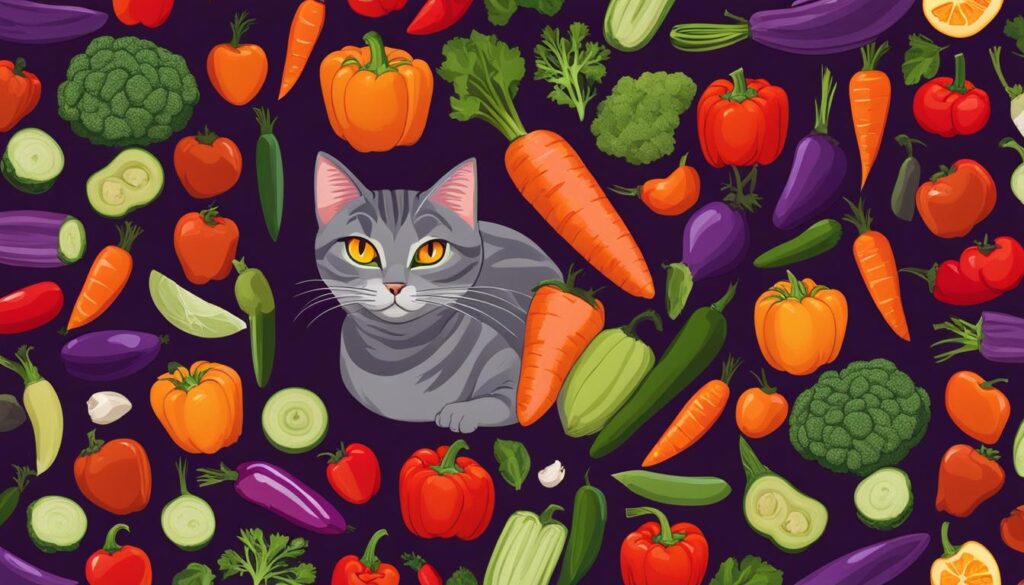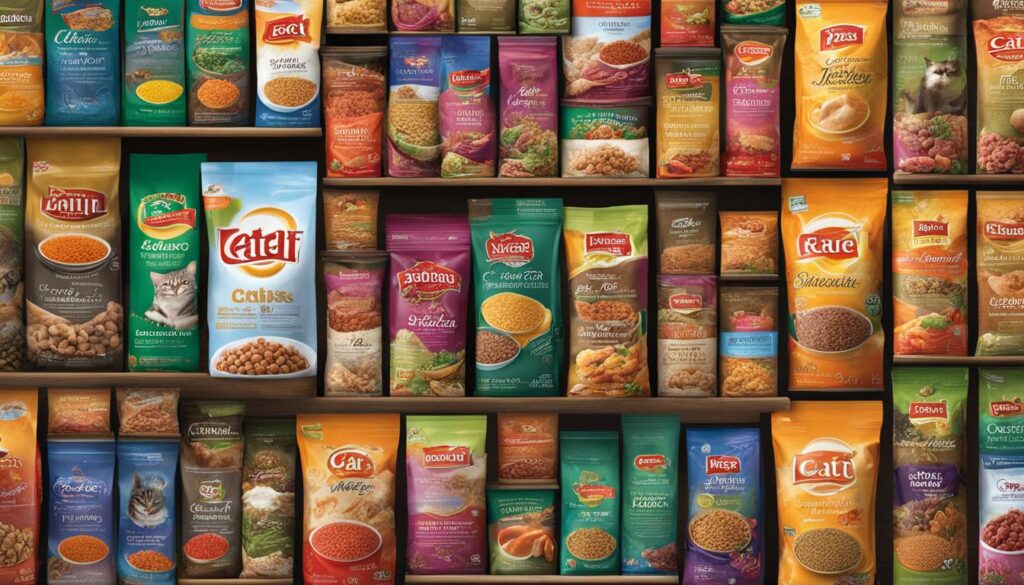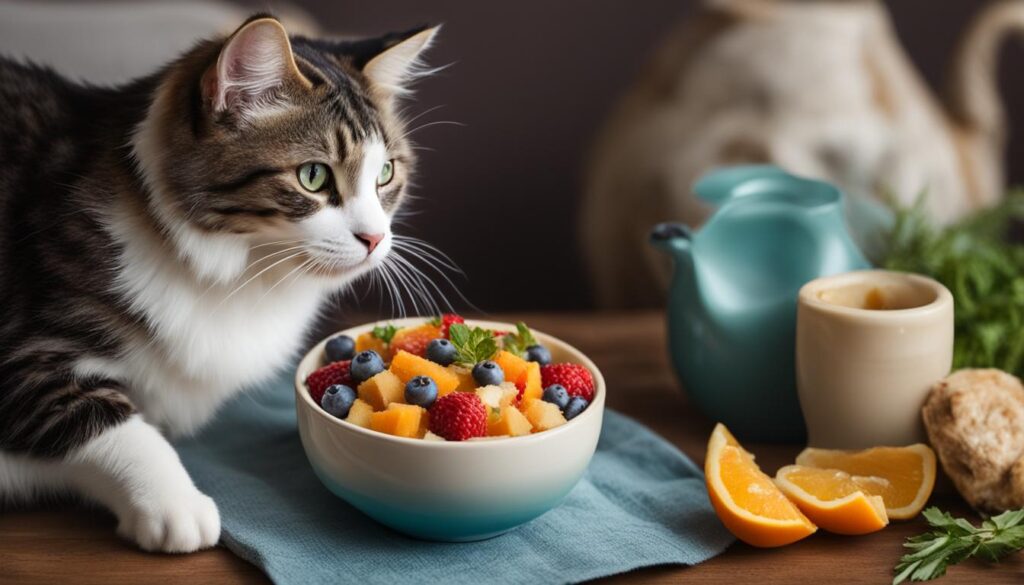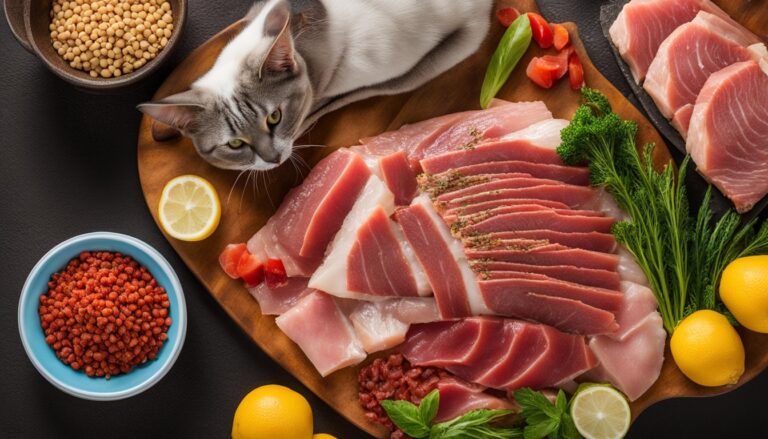Welcome to our article on feline diets! As a cat owner, you want to ensure that your furry friend is getting the best nutrition possible. One of the questions that often comes up is, “What can cats eat?” It’s important to understand that cats have specific dietary needs, and not all foods that are safe for humans are safe for our feline companions. In this article, we will explore the answers to this question and provide you with valuable information about cat food and cat-friendly human food.
Wichtigste Erkenntnisse:
- Cats can eat cooked lean meats like beef, chicken, turkey, liver, and lamb.
- Cooked and deboned fish like tuna is also safe for cats to eat.
- Cats can consume whole grains such as oats, corn, brown rice, and couscous.
- It’s important to avoid raw meats and fish as they can make cats sick.
- Consult with a veterinarian to determine the ideal diet for your cat.
Safe Human Foods for Cats: Meats and Fish
When it comes to feeding your beloved feline, it’s important to provide them with a diet that meets their nutritional needs. While cats are obligate carnivores and require meat as the main part of their diet, it’s essential to know which meats are safe for them to consume.
Cooked, lean meats like beef, chicken, turkey, liver, and lamb are great options for cats. These meats are not only delicious but also provide important nutrients. However, it’s crucial to ensure that the meat is thoroughly cooked and all skin and bones are removed before feeding it to your furry friend.
Aside from meats, cats can also enjoy cooked and deboned fish like tuna. Fish is a rich source of omega-3 fatty acids, which are beneficial for their overall health. Just like with meats, make sure the fish is cooked and all bones are removed to avoid any potential harm.
| Meats | Fish |
|---|---|
| Beef | Tuna |
| Chicken | |
| Turkey | |
| Liver | |
| Lamb |
Including these safe meats and fish in your cat’s diet can provide them with the necessary protein and other essential nutrients they need to thrive. Remember to always consult with your veterinarian before making any significant changes to your cat’s diet.
Benefits of Including Safe Meats and Fish in Cats’ Diet
- Provides necessary protein
- Rich source of essential nutrients
- Contributes to overall health and well-being
“Choosing the right meats and fish for your cat’s diet can be beneficial for their overall health and happiness.”
Human Foods Cats Can Eat: Whole Grains and Vegetables
If you’re wondering what human foods you can safely feed your cat, whole grains and vegetables can be a healthy addition to their diet. While cats are obligate carnivores and require meat as the main part of their diet, incorporating small amounts of whole grains and vegetables can provide them with additional nutrients.
Whole Grains for Cats
Whole grains such as oats, corn, brown rice, and couscous can offer cats a good source of protein and fiber. These grains can help support their digestive system and provide them with energy. When feeding your cat whole grains, it’s important to cook them thoroughly and avoid using any seasonings or additives that could be harmful to your cat.
Vegetables for Cats
Some vegetables can be a healthy treat for cats, as they are full of vitamins and minerals. However, it’s important to introduce them gradually into your cat’s diet and monitor their reaction. Vegetables like spinach, peas, and carrots can provide additional nutrients and add variety to their meals. Remember to always cook vegetables thoroughly before feeding them to your cat to ensure they are easily digestible.
| Vegetable | Vorteile |
|---|---|
| Spinach | High in iron and fiber |
| Peas | Rich in vitamins A, C, and K |
| Carrots | Provide vitamin A and promote healthy eyesight |
It’s important to note that not all vegetables are safe for cats to eat. Avoid feeding your cat onions, garlic, and other members of the allium family, as these can be toxic to cats. Additionally, it’s essential to consult with your veterinarian before introducing any new foods into your cat’s diet, to ensure they are receiving a balanced and suitable nutrition.
Summary
While cats require a diet that is mainly composed of meat, incorporating small amounts of whole grains and vegetables can provide them with additional nutrients. Whole grains such as oats, corn, brown rice, and couscous can offer cats protein and fiber. Some vegetables like spinach, peas, and carrots can provide vitamins and minerals. However, it’s important to introduce these foods gradually and cook them thoroughly before feeding them to your cat. Consulting with your veterinarian is always recommended to ensure your cat’s diet is balanced and appropriate for their individual needs.

Healthy Human Foods for Cats: Fruits and Dairy
Cats can enjoy a variety of healthy human foods in moderation, including certain fruits and dairy products. Fruits such as cantaloupe, bananas, and blueberries can be a tasty and nutritious addition to your cat’s diet. These fruits are rich in antioxidants and provide essential vitamins and minerals. However, it’s important to remember that cats are obligate carnivores, and fruits should only make up a small portion of their overall diet. When offering fruits to your cat, ensure that you remove any seeds, skins, or stems, as these can be harmful.
While some cats may enjoy small amounts of dairy products like cheese, it’s crucial to exercise caution. Many cats are lactose intolerant and can experience digestive issues if given large quantities of dairy. If you choose to offer your cat cheese, ensure it is in small portions and monitor for any signs of discomfort or upset stomach. It’s always best to consult with your veterinarian before introducing any new foods into your cat’s diet.
“A little fruit or a nibble of cheese can be a special treat for your cat, but it should never replace a balanced and complete cat food diet. Always prioritize your cat’s nutritional needs and consult with your veterinarian for guidance.”
Remember, the primary source of nutrition for cats should come from a complete and balanced cat food that is formulated to meet their specific dietary requirements. While it can be tempting to share human foods with your feline friend, it’s important to choose healthy and cat-safe options. Providing a well-rounded diet that includes high-quality cat food along with occasional small portions of fruits and dairy can contribute to your cat’s overall well-being and happiness.
Fruits and Dairy: A Summary
To summarize, here are some key points to keep in mind when considering fruits and dairy as part of your cat’s diet:
- Cats can enjoy certain fruits like cantaloupe, bananas, and blueberries in moderation.
- Fruits should only make up a small portion of a cat’s overall diet.
- Remove any seeds, skins, or stems from fruits before offering them to your cat.
- Some cats may tolerate small amounts of cheese, but be mindful of potential lactose intolerance.
- Always prioritize your cat’s nutritional needs and consult with a veterinarian before introducing new foods.
By following these guidelines and considering your cat’s individual needs, you can provide them with a safe and varied diet that includes healthy fruits and the occasional dairy treat.
| Fruits | Vorteile |
|---|---|
| Cantaloupe | Rich in antioxidants and vitamins A and C |
| Bananas | Good source of potassium and dietary fiber |
| Blueberries | High in antioxidants and vitamin C |
Table: Fruits for Cats – Benefits and Nutritional Information

Choosing the Right Cat Food: Dry vs. Wet
When it comes to feeding your feline friend, choosing the right cat food is essential for their health and well-being. One common decision cat owners face is whether to feed their cat dry food or wet food. Both options have their advantages and it’s important to consider your cat’s specific needs when making this choice.
Dry Cat Food:
Dry cat food, also known as kibble, is a convenient and commonly chosen option among cat owners. It has a long shelf life, doesn’t require refrigeration, and is easy to measure and serve. However, it’s important to note that dry cat food tends to have a higher carbohydrate count and lower protein content compared to wet food. This is because the manufacturing process for dry food involves cooking at high temperatures, which can reduce the overall nutritional value. While it’s still a viable option, if you choose to feed your cat dry food, ensure that it is a high-quality brand that contains balanced nutrients.
Wet Cat Food:
Wet cat food, also known as canned food, is another option to consider. It typically has a lower carbohydrate count and higher protein content compared to dry food. The high water content in wet cat food also helps with hydration, which is especially beneficial for cats who may not drink enough water on their own. Additionally, many cats find the texture and taste of wet food more appealing. However, wet cat food can be more expensive, needs to be refrigerated after opening, and can be messier to serve. It’s important to choose a high-quality wet cat food that provides complete and balanced nutrition for your cat’s needs.
Ultimately, the decision between dry and wet cat food will depend on your cat’s individual preferences, dietary needs, and any specific health concerns. Some cat owners may choose to feed a combination of both dry and wet food to provide variety in their cat’s diet. Consulting with your veterinarian can help you determine which option is best for your cat and ensure they are getting the necessary nutrients to thrive.
| Dry Cat Food | Wet Cat Food | |
|---|---|---|
| Convenience | ✔️ | ❌ |
| Nutritional Profile | Higher in carbohydrates, lower in protein | Lower in carbohydrates, higher in protein |
| Hydration | Requires additional water intake | Higher water content, aids hydration |
| Palatability | Varies among cats | Often preferred by cats |
| Shelf Life | Longer | Requires refrigeration |
| Cost | Lower | Higher |

Key Points:
- Choosing the right cat food is important for your cat’s health.
- Dry cat food is convenient but can have a higher carbohydrate count.
- Wet cat food has a higher water content and is more palatable for some cats.
- Consider your cat’s individual needs and consult with your veterinarian.
Senior Cat Food and Nutrition
As cats age, their nutritional needs may change. It is important to provide them with the right food to support their health and well-being. Senior cat food is specially formulated to meet the specific needs of older cats, considering factors such as their reduced activity levels, potential dental issues, and changes in metabolism. This section will discuss the importance of senior cat food and provide insights into feline nutrition for older cats.
The Benefits of Senior Cat Food
Senior cat food offers several benefits that are essential for the health of older cats. These specially formulated diets often contain a lower calorie content to prevent weight gain, as older cats are prone to becoming overweight or obese. They also contain higher levels of protein to support muscle maintenance and promote healthy aging. Additionally, senior cat food may include ingredients that support joint health, such as glucosamine and chondroitin, to help manage any age-related joint issues that may develop.
Furthermore, senior cat food may have added antioxidants and fatty acids to support the immune system and maintain healthy skin and coat. Some formulas also cater to specific urinary or kidney health needs, as these issues become more prevalent in older cats. Overall, senior cat food is designed to provide a balanced and age-appropriate diet that addresses the unique requirements of older cats.
Feline Nutrition for Older Cats
While senior cat food is important, it should not be the sole focus of a senior cat’s diet. It is still crucial to ensure that they receive a variety of nutrients from different sources. A combination of high-quality commercial cat food and occasional additions of home-cooked or raw food can provide a well-rounded diet. However, it is essential to consult with a veterinarian before making any dietary changes.
A balanced diet for older cats should include high-quality protein sources, such as lean meats or poultry, to support muscle mass and provide essential amino acids. It is also important to include easily digestible carbohydrates like whole grains and vegetables to provide energy. Additionally, to maintain hydration, wet or moist food should be included in the diet, as older cats may have a decreased thirst drive.
Lastly, senior cats may benefit from dietary supplements such as omega-3 fatty acids, probiotics, or joint support supplements. These can help address specific age-related concerns and support overall health. However, it is crucial to consult with a veterinarian to determine which supplements are suitable for your cat based on their individual needs.

| Key Considerations for Senior Cat Food | Vorteile |
|---|---|
| Lower calorie content | Prevents weight gain in older cats |
| Higher protein levels | Supports muscle maintenance and healthy aging |
| Joint support ingredients | Manages age-related joint issues |
| Added antioxidants and fatty acids | Boosts immune system and maintains healthy skin and coat |
| Specialized formulas for urinary or kidney health | Addresses common issues in older cats |
Schlussfolgerung
In conclusion, when it comes to the best food for your cat, it’s important to prioritize a healthy cat diet. While some human foods can be safe for cats to eat in moderation, it’s crucial to consult with a veterinarian to ensure that your feline friend receives all the necessary nutrients in a complete and balanced cat food.
Cats have specific dietary needs as obligate carnivores, and it’s essential to provide them with appropriate sources of protein, like cooked lean meats such as beef, chicken, turkey, liver, and lamb. Furthermore, including cooked and deboned fish like tuna as part of their diet can also be beneficial.
While whole grains and vegetables can be included in a cat’s diet, they should be supplemented with meat as the main part of their meal. It’s worth noting that cats have limited ability to digest carbohydrates and require a primarily meat-based diet for optimal health.
Lastly, when choosing between dry and wet cat food, consider their respective benefits. Dry cat food may be convenient, but wet cat food typically has a higher protein content and can help with hydration due to its higher water content. Ultimately, the right choice depends on your cat’s specific needs, so consulting with your veterinarian is essential.




